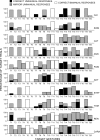Determinants of imitation of hand-to-body gestures in 2- and 3-year-old children
- PMID: 18422018
- PMCID: PMC2251323
- DOI: 10.1901/jeab.2008.89-183
Determinants of imitation of hand-to-body gestures in 2- and 3-year-old children
Abstract
Twenty children, ten 2-year-olds and ten 3-year-olds, participated in an AB procedure. In the baseline phase, each child was trained the same four matching relations to criterion under intermittent reinforcement. During the subsequent imitation test, the experimenter modeled a total of 20 target gestures (six trials each) interspersed with intermittently reinforced baseline trials. In each session, target gestures were selected in a pre-randomized sequence from: Set 1--ear touches; Set 2--shoulder touches; Set 3--midarm touches; and Set 4--wrist touches; subjects' responses to targets were not reinforced. In each target set, half the gestures featured in nursery matching games and were termed common targets whereas the remainder, which were topographically similar but did not feature in the games, served as uncommon targets. The children produced significantly more matching responses to common target models than to uncommon ones. Common responses were also produced as mismatches to uncommon target models more often than vice versa. Response accuracy did not improve over trials, suggesting that "parity" did not serve as a conditioned reinforcer. All children showed a strong bias for "mirroring"--responding in the same hemispace as the modeler. The 2-year-olds produced more matching errors than the 3-year-olds and most children showed a bias for responding with their right hands. The strong effects of training environment (nursery matching games) are consistent with a Skinnerian account, but not a cognitive goal theory account, of imitation in young children.
Figures







Similar articles
-
The impact of body-part-naming training on the accuracy of imitative performances in 2- to 3-year-old children.J Exp Anal Behav. 2011 Nov;96(3):291-315. doi: 10.1901/jeab.2011.96-291. J Exp Anal Behav. 2011. PMID: 22084492 Free PMC article.
-
Do infants show generalized imitation of gestures? II. The effects of skills training and multiple exemplar matching training.J Exp Anal Behav. 2009 May;91(3):355-76. doi: 10.1901/jeab.2009.91-355. J Exp Anal Behav. 2009. PMID: 19949493 Free PMC article.
-
Do infants show generalized imitation of gestures?J Exp Anal Behav. 2007 Jan;87(1):63-87. doi: 10.1901/jeab.2007.11-06. J Exp Anal Behav. 2007. PMID: 17345952 Free PMC article.
-
Imitation of gestures in children is goal-directed.Q J Exp Psychol A. 2000 Feb;53(1):153-64. doi: 10.1080/713755872. Q J Exp Psychol A. 2000. PMID: 10718068
-
Cerebral correlates of imitation of intransitive gestures: An integrative review of neuroimaging data and brain lesion studies.Neurosci Biobehav Rev. 2018 Dec;95:44-60. doi: 10.1016/j.neubiorev.2018.07.019. Epub 2018 Aug 4. Neurosci Biobehav Rev. 2018. PMID: 30086324 Review.
Cited by
-
The role of atomic repertoires in complex behavior.Behav Anal. 2012 Spring;35(1):59-73. doi: 10.1007/BF03392266. Behav Anal. 2012. PMID: 22942536 Free PMC article.
-
Dynamics of Simultaneous and Imitative Bodily Coordination in Trust and Distrust.Front Psychol. 2018 Aug 28;9:1546. doi: 10.3389/fpsyg.2018.01546. eCollection 2018. Front Psychol. 2018. PMID: 30210391 Free PMC article.
-
Spontaneous bodily coordination varies across affective and intellectual child-adult interactions.Front Psychol. 2024 Jan 16;14:1264504. doi: 10.3389/fpsyg.2023.1264504. eCollection 2023. Front Psychol. 2024. PMID: 38292530 Free PMC article.
-
The impact of body-part-naming training on the accuracy of imitative performances in 2- to 3-year-old children.J Exp Anal Behav. 2011 Nov;96(3):291-315. doi: 10.1901/jeab.2011.96-291. J Exp Anal Behav. 2011. PMID: 22084492 Free PMC article.
-
Do infants show generalized imitation of gestures? II. The effects of skills training and multiple exemplar matching training.J Exp Anal Behav. 2009 May;91(3):355-76. doi: 10.1901/jeab.2009.91-355. J Exp Anal Behav. 2009. PMID: 19949493 Free PMC article.
References
-
- Anisfeld M. Only tongue protrusion modeling is matched by neonates. Developmental Review. 1996;16:149–161.
-
- Anisfeld M. No compelling evidence to dispute Piaget's timetable of the development of representational imitation in infancy. In: Hurley S, Chater N, editors. Perspectives on imitation: From neuroscience to social science. Vol. 2. London: The MIT Press; 2005. pp. 107–131.
-
- Baer D.M, Deguchi H. Generalized imitation from a radical-behavioral view-point. In: Reiss S, Bootzin R, editors. Theoretical issues in behavior therapy. New York: Academic Press; 1985. pp. 179–217.
-
- Bandura A, Barab P.G. Conditions governing nonreinforced imitation. Developmental Psychology. 1971;5:244–255.
Publication types
MeSH terms
LinkOut - more resources
Full Text Sources

